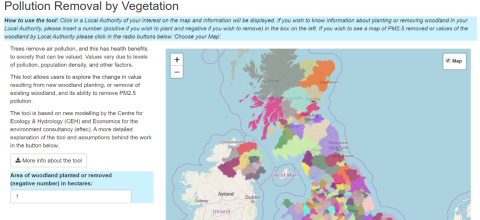
A new interactive online tool is set to encourage tree planting initiatives across the UK. It calculates how much pollution would be removed by planting trees in local areas, as well as the corresponding public health cost savings.
With hundreds of thousands of trees due to be planted across the country over the next three years in Government-backed schemes, the new tool – Pollution Removal by Vegetation – takes national data and makes it locally relevant and accessible for councils, NGOs, developers and other businesses that are considering such initiatives.
Scientists at the Centre for Ecology & Hydrology (CEH) teamed up with eftec, a leading environmental economics consultancy, to develop the tool, which shows the existing amount of woodland in each local authority in hectares, how much particulate matter (PM2.5) the trees remove from the air and the resulting predicted public health cost saving within that area over a 100-year period.
Based on the number of hectares of woodland someone wishes to plant within a local authority area, it can calculate:
- How many kilogrammes of PM2.5 – considered the most serious form of air pollution – would be removed from the air by the extra vegetation
- The resulting public health cost saving within that area over a 100-year period
The tool can also estimate the effects of felling existing woodland by calculating the health costs attributable to the PM2.5 that would no longer be removed from the air by those trees.
The new tool builds on previous research that CEH and eftec carried out for the Office of National Statistics, which estimated that plants in the UK remove 1.4 million tonnes of air pollution and save £1 billion in avoided health costs every year.
Professor Laurence Jones of the Centre for Ecology & Hydrology explains: “There is a lot of public concern about the potential health risks that pollution poses in many urban areas of the UK.
“While reducing harmful emissions at source is the best way to improve air quality, the addition of vegetation can play a role in removing pollutants within a local area.”
Ian Dickie of eftec adds: “Trees make urban areas more attractive and improve local air quality, thereby boosting people’s health. As our ongoing research has shown, this in turn can have significant positive economic benefits.
“We regularly hear political commitments to plant more trees in urban areas – our new online tool will inform and support the efforts by local and central government, NGOs, businesses and individuals in adding trees in our towns and cities.
“We were very pleased with the positive feedback we received about the valuation tool from these stakeholders at a recent webinar and hope it will encourage and support their tree planting initiatives in pollution hotspots.”
To access the free online tool, visit https://shiny-apps.ceh.ac.uk/pollutionremoval/
You can also download a method note that explains the model and its uses.
The recording of the launch webinar hosted by EKN is now available at https://vimeo.com/341991556 and it takes you through the tool’s development and uses.
Notes to editors
- Plants remove air pollution by providing a large surface area for particulate matter to settle on, and by active uptake of gases into the leaves or chemical reactions with the leaf surface. Collectively these processes are called ‘dry deposition’.
- CEH and eftec plan to develop the online tool so it can also calculate the amount of nitrogen dioxide and sulphur dioxide that will be removed by altering the amount of woodland within a local authority area.
- The Government recently launched its Urban Tree Challenge Fund, with £10m available in grants to individuals, local authorities and NGOs. This will fund the planting of more than 130,000 trees in England’s towns and cities, and help its target of one million more urban trees by 2022.
Contact information
For interviews and further information, please contact Simon Williams, Media Relations Officer at CEH, via simwil@ceh.ac.uk or 07920 295384.
About the Centre for Ecology & Hydrology
The Centre for Ecology & Hydrology (CEH) is the UK’s centre for excellence in environmental science across air, land and water. CEH is a Natural Environment Research Council (NERC) research institute, part of UK Research and Innovation (UKRI). Our research extends from molecular biology to global climate modelling, and our fieldwork is carried out across the world, from the peatlands of Scotland to the semi-arid West African Sahel. For over 50 years, our experts have monitored and modelled environmental change, generating evidence-driven solutions to complex environmental challenges. We are home to over 350 environmental scientists, based across four sites in Edinburgh, Lancaster, Bangor and Wallingford.
www.ceh.ac.uk @CEHScienceNews
About the Economics for the environment consultancy
The Economics for the environment consultancy (eftec) was established in 1992, as the first consultancy in the UK to apply environmental economics to public policy and business challenges. It conducts sound economic analysis, measuring what is conventionally not measured, aiming to provide comprehensive, high quality and clear evidence to support decision making. eftec is internationally recognised for its expertise in natural capital accounting and works from national level to the local. It led the work for the first Natural Capital Committee on gathering physical and economic data on natural capital assets in England, and prioritising natural capital investments to inform the 25 Year Environment Plan. eftec has produced natural capital accounts at a variety of scales, including for the Greater Manchester Combined Authority (GMCA), which was the basis for developing its natural capital investment plan.